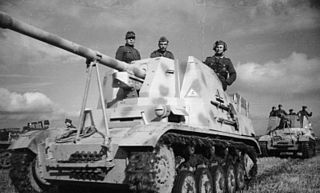
The Panzer II is the common name used for a family of German tanks used in World War II. The official German designation was Panzerkampfwagen II.

Marder III was the name for a series of World War II German tank destroyers. They mounted either the modified ex-Soviet 76.2 mm F-22 Model 1936 divisional field gun, or the German 7.5 cm PaK 40, in an open-topped fighting compartment on top of the chassis of the Czechoslovakian Panzer 38(t). They offered little protection to the crew, but added significant firepower compared to contemporary German tanks. They were in production from 1942 to 1944, and served on all fronts until the end of the war, along with the similar Marder II. The German word Marder means "marten" in English.

The Marder II was a German tank destroyer of World War II based on the Panzer II chassis. There were two versions, the first mounted a modified Soviet 7.62 cm gun firing German ammunition, while the other mounted the German 7.5 cm Pak 40 gun. Its high profile and thin open-topped armor provided minimal protection to the crew. Nevertheless, the Marder II provided a great increase in firepower over contemporary German tanks during 1942 and into 1943. Only four Marder IIs remain today.

The Marder I "Marten" was a German World War II tank destroyer, armed with a 75 mm Pak-40 anti-tank gun. Most Marder Is were built on the base of the Tracteur Blindé 37L (Lorraine), a French artillery tractor/armoured personnel carrier of which the Germans had acquired more than three hundred after the Fall of France in 1940.

The Hotchkiss H35 or Char léger modèle 1935 H was a French cavalry tank developed prior to World War II. Despite having been designed from 1933 as a rather slow but well-armoured light infantry support tank, the type was initially rejected by the French Infantry because it proved difficult to steer while driving cross-country, and was instead adopted in 1936 by the French Cavalry arm.

The Lorraine 37L or Tracteur de ravitaillement pour chars 1937 L, is a light tracked armoured vehicle developed by the Lorraine company during the interwar period or interbellum, before the Second World War, to an April 1936 French Army requirement for a fully armoured munition and fuel supply carrier to be used by tank units for front line resupply. A prototype was built in 1937 and production started in 1939. In this period, two armoured personnel carriers and a tank destroyer project were also based on its chassis. Mainly equipping the larger mechanised units of the French Infantry arm, the type was extensively employed during the Battle of France in 1940. After the defeat of France, clandestine manufacture was continued in Vichy France, culminating in a small AFV production after the liberation and bringing the total production to about 630 in 1945. Germany used captured vehicles in their original role of carrier and later, finding the suspension system to be particularly reliable, rebuilt many into tank destroyers of the Marder I type or into self-propelled artillery.

The SOMUA MCG was a half-track artillery tractor and recovery vehicle of the French forces during World War II.

The 47 mm APX anti-tank gun was a French anti-tank gun that saw service in the first years of the Second World War.
The Panzerkampfwagen I was a light tank produced in Germany in the 1930s. The Panzer I was built in several variants and was the basis for a number of variants listed below.
Alfred Becker was a German engineer and artillery officer who served during the First and Second World Wars. During the Second World War he took captured British and French vehicles and refurbished and rebuilt them to supply the German army with armoured fighting vehicles. With his engineering and organizational skills, he converted the Hotchkiss plant on the outskirts of Paris into a vehicle modification and fabrication center. He used the vehicles to mobilize German guns, rocket launchers and mortars. Working with Altmärkische catenary Gmbh (Alkett), steel shielding was shipped from Germany to armour the vehicles. The men from his artillery command did the metal work and conversion on 1,800 recovered vehicles.

The 8 cm Raketen-Vielfachwerfer was a copy of the Soviet BM-8 Katyusha multiple rocket launcher produced in Nazi Germany during the Second World War.







